Pond Cleaning & Maintenance Service in Watford
If your pond is looking a little murky, our team of experts can help.
CONTACT US
Why pond maintenance is essential
Whether you have a corporate pond, school pond, garden pond or any size, all of them require maintenance every 5-10 years based on their size. Due to the different types of weather Britain has, dirt, debris, algae, and a foul smelling toxic odour can accumulate quickly. This can easily strain your filter, harm your ornamental features and decrease the lifespan of any marine life you have in your pond if you do not regularly remove algae.
Soon enough, your aquatic oasis can turn into a hazardous environment for your fish, depriving them of light and oxygen. Don’t let these issues disbalance your pond’s ecosystem. With our comprehensive pond cleaning services, premium grade pond cleaning equipment and extensive experience, we ensure your pond’s longevity will flourish with Anthony and his team.
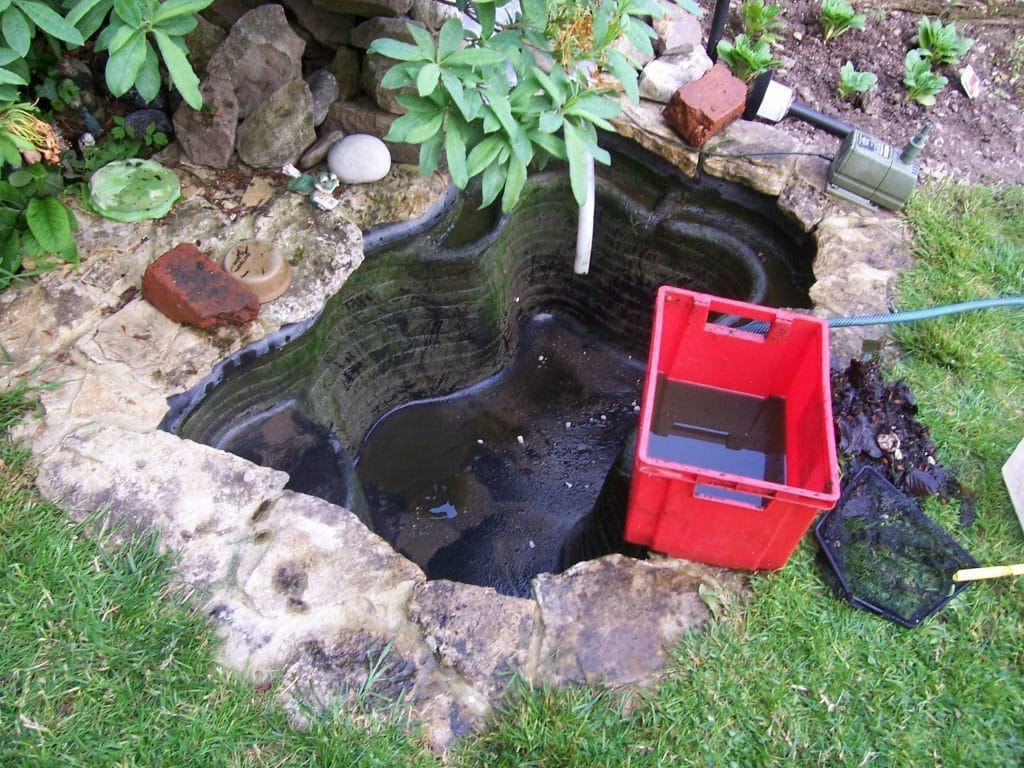
Pond cleaning and maintenance
Bring back the beauty of your pond and elevate its internal environment, with our thorough pond cleaning services.
What is Pond Maintenance?
Pond maintenance is the ongoing process of keeping your pond in optimal condition to ensure the health and well-being of its inhabitants. This involves regular cleaning, monitoring water quality, and maintaining essential equipment like filters and pumps. Without proper pond maintenance, waste and debris can accumulate, leading to poor water quality that can harm fish and other aquatic life. By staying on top of these tasks, you can prevent issues such as algae growth and ensure a thriving, healthy pond environment.
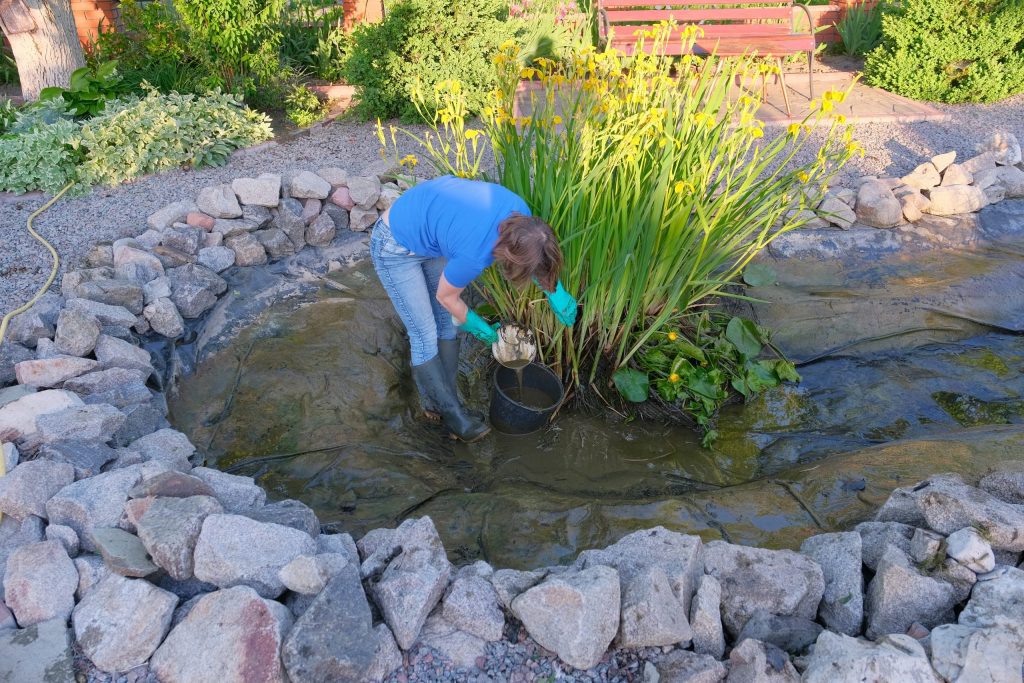
Pond Water Quality
Maintaining high pond water quality is crucial for the health of your fish and other aquatic life. Poor water quality can lead to problems like algae growth, which depletes oxygen levels and can be detrimental to fish. Regular testing of your pond water is essential to keep it healthy and vibrant. Key factors to monitor include pH levels, ammonia, nitrite, and nitrate levels, as well as the presence of beneficial bacteria. These elements play a significant role in maintaining a balanced and thriving pond ecosystem.
Pond Plant Care
Pond plants are vital for a healthy pond ecosystem, providing food and shelter for fish and other aquatic life while helping to maintain good water quality. Regular care and maintenance of pond plants are necessary to ensure they thrive and continue to benefit the pond. This includes tasks such as pruning, dividing, and fertilizing the plants, as well as monitoring for signs of disease or pests. By taking good care of your pond plants, you contribute to a healthier and more balanced pond environment.
Fish Health and Maintenance
Ensuring the health and well-being of your fish is a critical aspect of pond maintenance. Regular monitoring of fish health is essential to ensure they are thriving and free from disease. Factors that can affect fish health include water quality, temperature, and the presence of beneficial bacteria. Additionally, maintaining fish habitats by cleaning and replacing gravel and decorations is crucial for providing a healthy and thriving environment for your fish. By prioritizing fish health, you can enjoy a vibrant and lively pond.
Pond cleaning and maintenance
Bring back the beauty of your pond and elevate its internal environment, with our thorough pond cleaning services. Our services are especially beneficial for deeper ponds where oxygen diffusion is less effective.
Our pond cleaning process
Pond maintenance and cleaning is not a one size fits all process. Ultimately it depends on the size of your pond, structure, inhabitants and location. After an initial inspection, we’ll work with you to provide a customised cleaning process that preserves the health of your pond for as long as possible.
We also offer pond hoovering cleaning services and cater to private and business pond maintenance contracts. With cutting edge pond cleaning equipment, we strive to provide you with a total restoration, often within 24-72 hours.
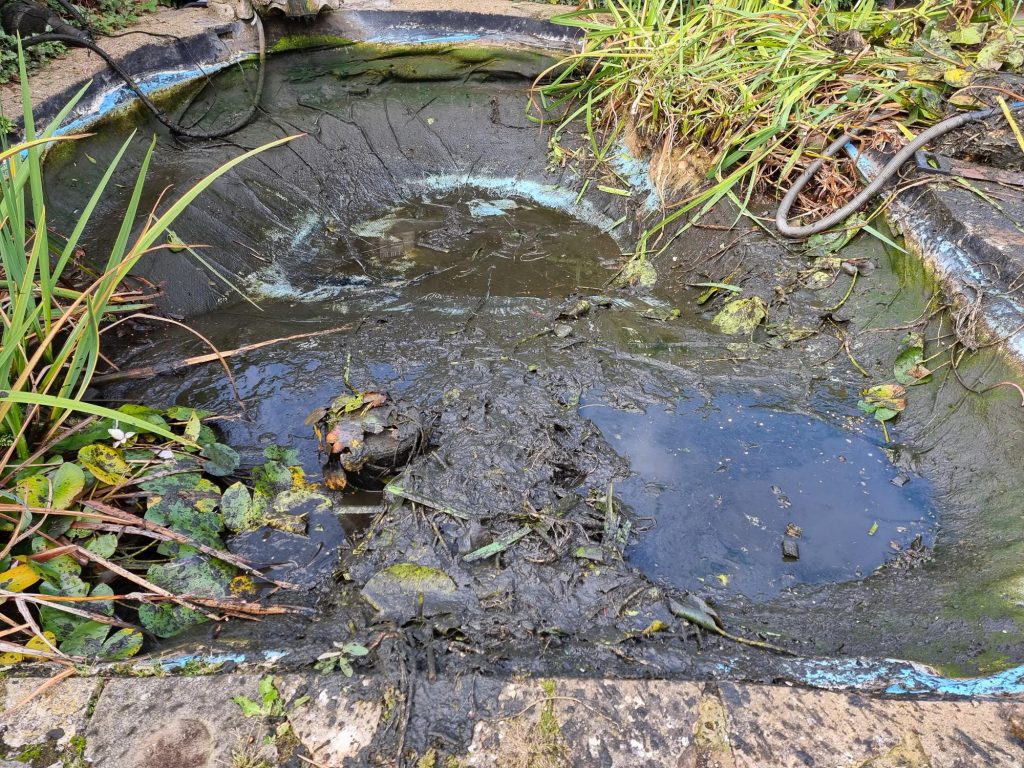
Steps to securing a healthy pond
Generally, our comprehensive clean consists of:
- Draining the pond/water feature fully
- Placing all fish/wildlife into an aerated holding tank
- Cleaning the pond liner using a power washer
- Removing all debris/sludge from the pond by vacuuming out
- Removing excess vegetation if required
- Cleaning the pond filter
- Cleaning the pond pump
- Changing the UV bulb (If needed and requested)
- Cleaning the quartz sleeve (If needed and requested)
- Carrying out any repairs if needed
- Refilling the pond with water from the pond and topped up with tap water.
- Treatments added-dechlorinator and bacteria to start the filter.
- Restarting the system as a back up
- Reinstalling the Fish & Wildlife
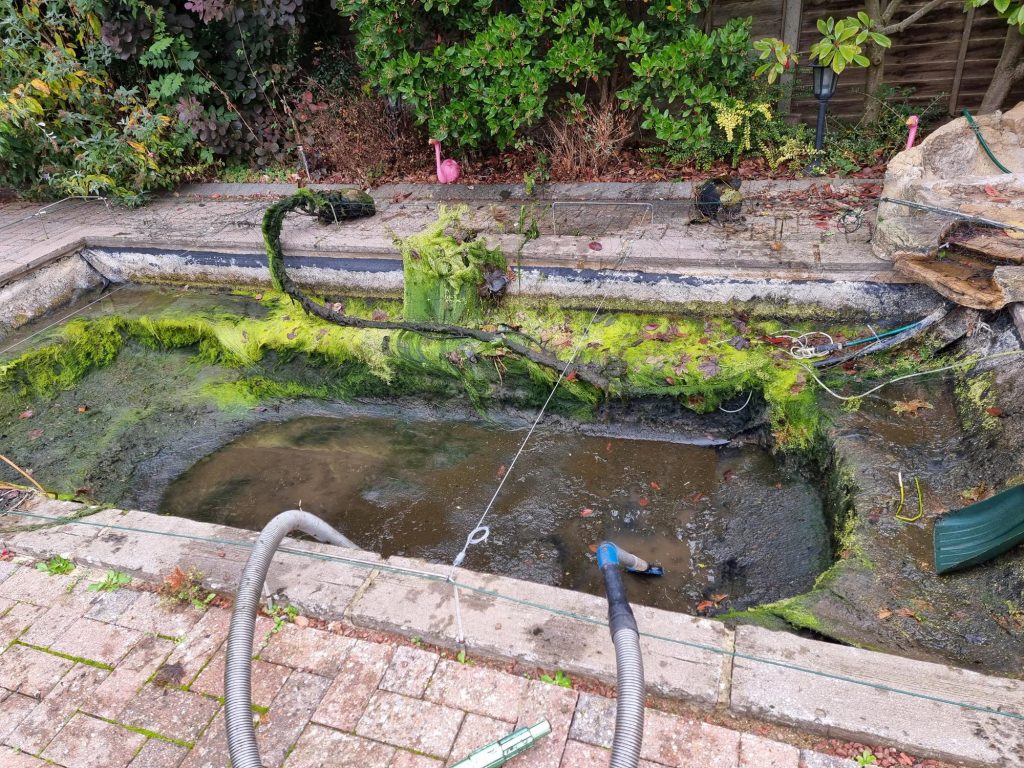
Receive a first class clean from us
When it comes to pond cleaning and maintenance, we’re known for our attention to detail. We also pay close attention to water temperature to ensure the health and well-being of your pond’s inhabitants. While every pond is unique, we always strive to provide competitive prices that are comfortable for our customers.
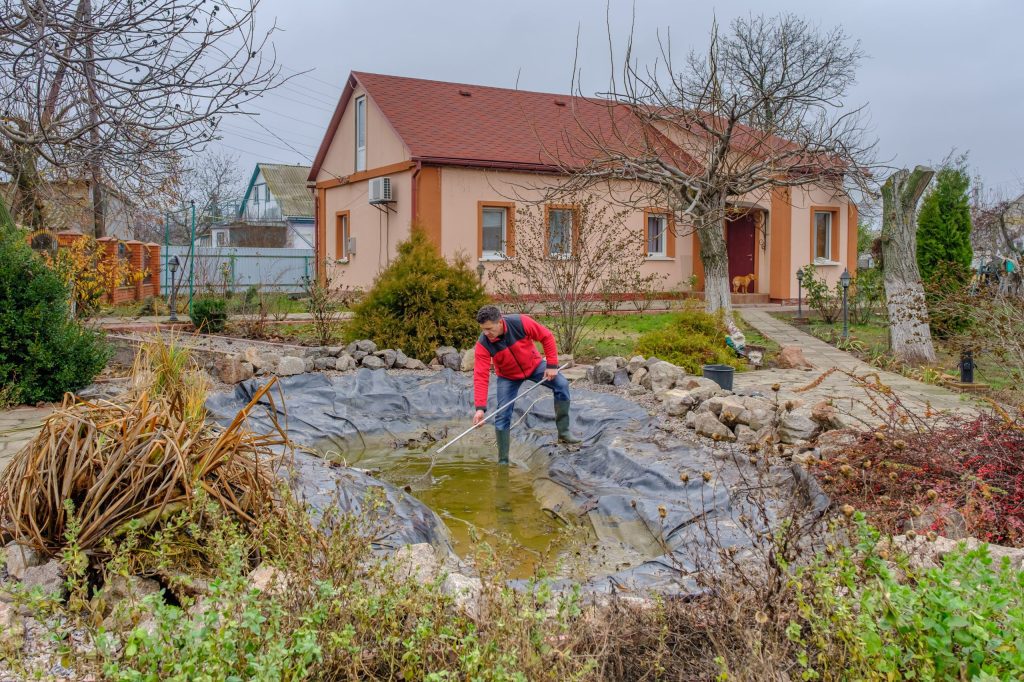
Our maintenance contracts have different levels from total peace of mind to a yearly visit. This package leaves you with total peace of mind and means you don’t need to carry out any maintenance yourself at all.
What comes with this package:
Complete Maintenance Package
Total of 6 visits through-out the year.
2 Seasonal visits and 4 Maintenance visits
Seasonal visits could Include:
- Complete pond liner vacuuming
- Clean debris from the bottom of the pond by vacuuming (once a year)
- Cut back pond plants
- Clean and service all pond equipment (pump and filter)
- Check water parameters e.g.pH, kH, gH, NO2, NO3, etc.
- Treat for phosphates
- UV bulb change (if applicable)
- Pump and filter strip apart clean
- Treatment for blanket weed if needed
- Equipment check
Maintenance visit to include:
- Clean of the pump and filter set
Helpline support Monday–Friday, 9am–5pm
Emergency call-outs throughout the year for any equipment issues.
This package means you will have much less maintenance to take care of. It takes a weight off your shoulders, however, also gives you the freedom to complete some maintenance yourself.
What comes with this package:
Total of 4 visits through-out the year.
2 Seasonal visits and 2 Maintenance visits
Seasonal visits could Include:
- Complete pond liner vacuuming
- Cut back pond plants
- Clean and service all pond equipment (pump and filter)
- Check water parameters e.g.pH, kH, gH, NO2, NO3, etc.
- Treat for phosphates
- UV bulb change (if applicable)
- Pump and filter strip apart clean
- Treatment for blanket weed if needed
- Equipment check
Maintenance visit to include:
- Clean of of the pump and filter set
Helpline support Monday–Friday, 9am–5pm
Emergency call-outs throughout the year for any equipment issues.
If you’re wanting a small amount of maintenance to keep your pond flourishing throughout the year, then this will be your package of choice.
What comes with this package:
Total of 2 visits through-out the year.
Visits could Include:
- Cut back pond plants
- Clean and service all pond equipment (pump and filter)
- Check water parameters e.g.pH, kH, gH, NO2, NO3, etc.
- Treat for phosphates
- UV bulb change (if applicable)
- Pump and filter strip apart clean
- Treatment for blanket weed if needed
- Equipment check
Helpline support Monday–Friday, 9am–5pm
Emergency call-outs throughout the year
MY POND IS OVERGROWN.
If you have a small pool and the plants have not been managed for a number of years, you can simply cut them back or pull some of them out. You do have to be careful however as very often these pools have good water quality because the plants are absorbing the nutrients. The key thing then, is not to rip out too many of the plants because you can go from clear, relatively nice-looking water to something full of algae, simply because you have pulled too many of the plants out.
If you have a much bigger pond, a lake or a lochan then commonly some of the problems are with some of the very vigorous plants like bulrush or Norfolk reed and these need spraying off, and that is the best way to control them. Ideally you do not plant Typha (bulrush) or Norfolk reed in ornamental systems simply because they tend to take over completely. There is also a small-leafed lily called Nymphoides peltata which you have to avoid like the plague and these all need spraying in order to control them.
MY POND IS LEAKING – WHAT CAN I DO?
Probably the commonest problem that we get approached with is a pond that is leaking and there are various steps you can take to diagnose what’s going on
- If you have a pump and a stream or waterfall and the pond is going down, turn the pump off and the fill the pond up. If you do not get any water loss then, it means that the problem is either in the hose from the pump to the top of the water course, or in the water course, which is actually the commonest cause. If it is in the water course, put the pump back on and see if you can see anywhere where the water is actually leaking out the sides either over a liner or through concrete or whatever. Once you locate it, you can fix it.
- The other thing that can happen is simply debris accumulating in narrow points in the stream or cascade backing the water up behind it and it then flowing out the sides, and you lose water that way.
- Assuming you have not got a water course, or that the leak is not there, then the other obvious problem is a hole in the liner. Again, if you do not fill the pond up and let the pond drop, it will eventually drop to where the hole is, you can then find it and potentially patch it.
- One other cause of ponds going down is a liner that is behind stones or something, somebody stands on the stone, pushes the liner down and the water runs out over the top of a new low point and you end up with what looks like a leak. If you can locate that, just pull the liner back up and you will not have a leak any more
WHY IS MY POND WATER GREEN?
There may be a number of reasons why your pond is so green. First of all, you may have too small of a pump or filter for the size of your pond. Secondly, your pond may be in full sun which creates a perfect environment for algae blooms, or the pond is very shallow, particularly around the edges and doesn’t get much water circulation. You can remedy these things by first checking your pump and filter size for your pond. If it is in full sun, you will have to increase the size of the filter and pump to compensate for the increased algae blooms that will occur in full sun. If you recently made a water exchange or filled your pond within a few weeks, you may need to be patient as your pond hasn’t found it’s ecological balance yet. If it’s a brand new pond, I would recommend waiting at least 4-6 weeks for your pond to find it’s balance. Hold off on any chemicals. Add some Microbe Lift which is all-natural beneficial bacteria and organic barley straw bales to your pond. This increases the function of your biological filter and combats algae blooms including string algae. Every pond should have them.
One point to note, is that you must be equipped with a large enough pump, filter and biological media for the beneficial bacteria to grow on and be patient and allow the pond to find it’s natural ecological system. You want to try to correct the problem instead of needing to add chemicals to it all the time. Another thing that could be adding to your algae blooms is the frequent addition of cold tap water to your pond. Whenever you add cold tap water to your pond and the pond is in the heat of full sun, it creates a great environment for algae to increase. Try to eliminate adding tap water to your pond and you just may reduce the algae. Every time you add tap water, your pond has to adjust and find it’s eco-balance. If you’re continually adding more water to your pond, your pond will never really balance itself and you’ll try to combat algae and ammonia levels all the time. In either of these situations, get at the root of the problem whether it’s the wrong pump or filter size or the addition of cold tap water and see if it doesn’t correct itself. If you’re having a problem with this and need some advise, contact us and we’ll be happy to assist you. If you need to add tap water, run the water through some Super Activated Filter Carbon to take out the chlorine and chloramine and add more beneficial bacteria to it afterwards.
Do I need to have my pumps running all the time?
Pumps give your pond water circulation. If they are the right size for your pond and are properly placed, they eliminate stagnant water and provide oxygen to your pond. If they are connected or pumped to a filter, you reduce the effectiveness of the filter if your pump is not on and may end up having unsightly water and elevated levels of ammonia providing you have fish. If you have multiple pumps, you most likely may not need to have all of them running as long as you have at least 1/2 the total gallons of your pond pumped every hour (there is a different formula for very large ponds – contact us and we will assist you in calculating proper aeration for your pond) for good water circulation. So, as long as you have good circulation and enough oxygen in your pond, you don’t necessarily need to have all of your pumps running all of the time.
Related Posts
- Why Are My Pond Plants Turning Yellow and Dying: Understanding Common Causes and Solutions
- I Want Someone to Build Me a Pond: Key Considerations for Your Project
- Koi White Spot Treatment: Effective Solutions for Your Pond Fish
- Common Koi Fish Diseases to Look Out for in Garden Ponds: Essential Guide for Pond Owners
